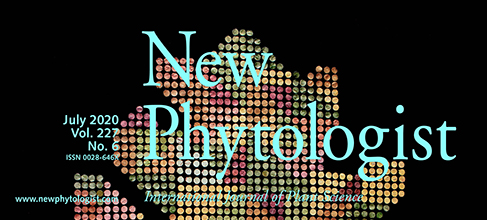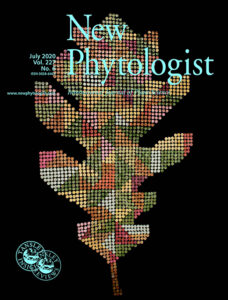
New Phytologist
“When I heard that my work was selected for the cover, It was a big surprise. First, because I don’t usually see art pieces on the cover of scientific journals. Secondly, because It wasn’t created with that in mind.”

Big Congratulations to Adrianna Cavalcanti, who is a second-year IMFA student, as her piece Biomimicry has been published on the cover of the Botanical Magazine: New Phytologist. Read more about her work below, a statement that was given to the magazine editors.
“The interesting fact about that cover is that the piece itself was not created with that in mind. It was created a year ago, last autumn. I named that piece Biomimicry, and I created it because I was inspired by the ways that technology is intertwining science and nature. Scientific knowledge is advancing in progressive speed facilitated by nanotechnology and automated computerized systems. To not even mention historically, how nature observations have led to the development of mechanical engineering, architecture, and design, from the creation of airplanes, filtration systems, and even the invention of Velcro. That general subject came to mind possibly from my background and my own experiences as a botanist. Coincidentally this piece recently became a conversation topic with my husband, Jose Eduardo Meireles, because of the research that he is doing with light reflectance and biodiversity data. He was the one who had the vision of how the Biomimicry piece would be a good fit for that magazine, where he was publishing an article. We learned that the magazine accepts submissions for the cover, which depicts the main topic of the current issue. When I heard that my work had been selected for the cover, it was a big surprise. Firstly, because I don’t usually see art pieces on the cover of scientific journals. Secondly, because it wasn’t intentionally created with that in mind. For me, it is just an example of how open-minded we need to be about our creations. The importance of leaving space for people to get their perception of art. When too obvious, art becomes limited and may be easily negligible. Conceptual art, it stronger when the subject is apparent, but instead of giving all the answers, it creates a conversation topic. Leaving that open conversation between the imagery and the viewer, that is what allowed the piece to fit right into the subject. I am currently a graduate student from the Intermedia Program, where I feel encouraged to incorporate the interdisciplinary approach. I take every opportunity to learn new media. In this program, I am always searching for new ways to connect science and nature. The Biomimicry piece does exactly that, in ways that go beyond what is seeing in the magazine cover. The creation required simple tools, using reclaimed wood, a hole punch, and lots of time. However, it also requires me to go for walks in nature to collect a variety of leaves, to achieve the colored aspect that I was looking for, and that consequently speaks of diversity. It also required me to sit for hours punching leaf holes, and carefully glue each miniature circle in its designated spot. This was a process that was meditative and makes me wonder about the concept of time in nature. When seen in person, the picture compels people to look closely, to note every little circle, which reminded me of looking at a leaf through a microscope.”
Brief Artist Statement:
We have for long observed nature and learned from that. Inspired by nature, we have developed technologies that helped us thrive. From the creation of the first fabric to the engineering of airplanes, we have been imitating nature. This piece portrays an Oakleaf, composed of colorful geometric shapes formed by tiny leaf dots from a variety of plant species. It is representing biodiversity and technology, both; intertwined with a single purpose. From my perspective, it is a reminder that technology and nature can walk together, and both be beneficiated from that.
Learn More about the Magazine Here: https://nph.onlinelibrary.wiley.com/toc/14698137/2020/228/2
